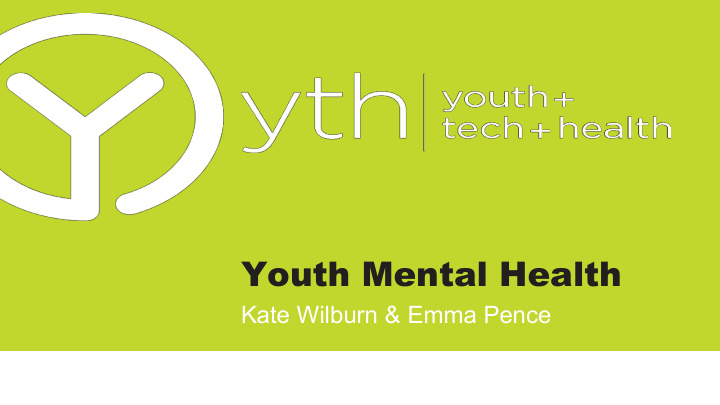



Youth Mental Health Kate Wilburn & Emma Pence
Background • 1 in 5 youth in the U.S. have or will have a serious mental illness 1,2 • Mental disorders make up half of the disease burden for youth in the U.S. 3 • 75% of all lifetime cases of mental illness begin by age 24 1 • Suicide is the second highest cause of death in youth in high-income countries, and the third leading cause of death in the U.S. 1,4,5
Disorders and Prevalence Rates in the U.S. 13-18 year olds: 18-24 year olds: Most common disorders by prevalence 6 : 1. Substance use disorders 2. Personality disorders 3. Anxiety disorders 4. Mood disorders Distribution of the major classes of DSM-IV disorders among youth in the U.S. with at least one disorder (N=6,483). 2
Factors Associated with Mental Illness in Youth • Socioeconomic Status • Minority Youth • Self-esteem, Coping, Resilience & Social Support • Child Maltreatment & Trauma • Bullying • Sleep • Stress
Help-Seeking & Access to Care • In the US, it is estimated that less than a quarter to a half of youth with mental disorders receive services 8,9 • Help-seeking rates have been found to range from 10-34% 10,11,12 • Youth are most likely to be treated for ADHD and other behavior disorders and least likely to be treated for anxiety disorders 7
Help-Seeking & Access to Care • Stigma • Self-reliance • Perceived need for help • Concerns about effectiveness of treatment • Confidentiality and trust of providers • High social support • Access to care
Technology & Mental Health • Well-being: self-esteem, social support, depression • Cyberbullying • Online content • Technology interventions: treatment, promotion, prevention
Conclusions & Recommendations Countless societal, individual, interpersonal, and institutional factors threaten the mental and emotional wellness of youth. Many of these factors also create barriers to youth receiving the mental health services they need. • Girls, Hispanic, and African American youth: interventions focusing on mood and anxiety disorders • Boys: interventions focusing on behavior disorders and substance use • College students: interventions focusing on stress, sleep, and substance use • Early adolescents: interventions focusing on bullying, anxiety, and behavior disorders • LGBTQ youth: interventions focusing on suicide prevention • Social media can be used as a tool to decrease stigma, identify youth in need of services, and connect them with resources or other youth experiencing mental health issues
Intervention Ideas • Website designed to encourage help-seeking in youth, give informal support and encourage formal care by providing resources • Computerized CBT program tailored to Latino American and African American youth • Web or mobile app for suicide prevention in LGBTQ youth • Social media campaign aimed at girls for prevention or awareness of mood and anxiety disorders • Videogame aimed at boys for preventing or treating behavior and substance use disorders • Web or mobile app for college mental wellness that integrate self-care and counseling sessions • SMS campaign for youth that sends bi-weekly health tips
References 1. National Alliance on Mental Illness. Mental Health Facts: Children & Teens. Retrieved from https://www.nami.org/getattachment/Learn-More/Mental-Health-by-the-Numbers/childrenmhfacts.pdf 2. Merikangas, K. R., He, J. P., Burstein, M., Swanson, S. A., Avenevoli, S., Cui, L., ... & Swendsen, J. (2010). Lifetime prevalence of mental disorders in US adolescents: results from the National Comorbidity Survey Replication–Adolescent Supplement (NCS-A). Journal of the American Academy of Child & Adolescent Psychiatry, 49(10), 980-989. 3. World Health Organization. (2011). The global burden of disease: 2004 update. Geneva: World Health Organization; 2008. 4. United Nations. (2014). Social inclusion of youth with mental health conditions. Retrieved from http://www.un.org/esa/socdev/documents/youth/youth-mental-health.pdf. 5. Hawton, K., Saunders, K. E., & O'Connor, R. C. (2012). Self-harm and suicide in adolescents. The Lancet, 379(9834), 2373-2382. 6. Blanco, C., Okuda, M., Wright, C., Hasin, D. S., Grant, B. F., Liu, S. M., & Olfson, M. (2008). Mental health of college students and their non–college-attending peers: results from the national epidemiologic study on alcohol and related conditions. Archives of general psychiatry, 65(12), 1429-1437. 7. Merikangas, K. R., He, J. P., Burstein, M., Swendsen, J., Avenevoli, S., Case, B., ... & Olfson, M. (2011). Service utilization for lifetime mental disorders in US adolescents: Results of the National Comorbidity Survey–Adolescent Supplement (NCS-A). Journal of the American Academy of Child & Adolescent Psychiatry, 50(1), 32-45. 8. Gulliver, A., Griffiths, K. M., & Christensen, H. (2010). Perceived barriers and facilitators to mental health help-seeking in young people: a systematic review. BMC psychiatry, 10(1), 1. 9. Bains, R. M. (2014). African American adolescents and mental health care: a metasynthesis. Journal of Child and Adolescent Psychiatric Nursing, 27(2), 83-92. 10. Hunt, J., & Eisenberg, D. (2010). Mental health problems and help-seeking behavior among college students. Journal of Adolescent Health, 46(1), 3-10. 11. McLean, C. P., Asnaani, A., Litz, B. T., & Hofmann, S. G. (2011). Gender differences in anxiety disorders: prevalence, course of illness, comorbidity and burden of illness. Journal of psychiatric research, 45(8), 1027-1035.
Recommend
More recommend